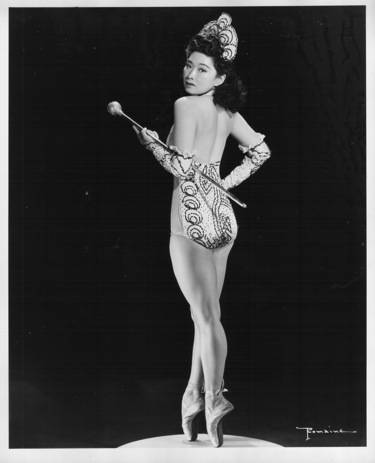Ellen Chinn: Difference between revisions
(biography of Ellen Chinn) |
No edit summary |
||
| Line 5: | Line 5: | ||
'''"The Betty Grable of Chinatown" | '''"The Betty Grable of Chinatown" | ||
''' | ''' | ||
[[Image:]] | [[Image:EllenChinnMajorette.jpg]] | ||
''' | '''Dancer Ellen Chinn, known as the Betty Grable of Chinatown, performed at Charlie Low's Forbidden City nightclub and other Chinatown clubs from 1937 until 1946.''' | ||
''Image: | ''Image: Courtesy of Candace Poinciano” | ||
Ellen Chinn grew up in Monterey, California, the daughter of a traditional Chinese family. Like many Asian-American girls who came of age in the 1920s and 1930s, she followed the popular entertainment, music and dancing of the day. She most definitely caught the performance bug, and decided to break out on her own. Her daughter, Candace Poinciano, who also went on to a career as a nightclub dancer, says that her mother spoke little of her childhood and early career. She recalls, “I think she ran away from home. She was probably underage. As far as I know, she lived on John Street, which is in the Chinatown area, and that was with girlfriends, but she was raised in Monterey. And I know she ran away and was dancing on the stage, and I know grandfather went to the club, grabbed her off the stage, brought her home, and she ran away again.” | Ellen Chinn grew up in Monterey, California, the daughter of a traditional Chinese family. Like many Asian-American girls who came of age in the 1920s and 1930s, she followed the popular entertainment, music and dancing of the day. She most definitely caught the performance bug, and decided to break out on her own. Her daughter, Candace Poinciano, who also went on to a career as a nightclub dancer, says that her mother spoke little of her childhood and early career. She recalls, “I think she ran away from home. She was probably underage. As far as I know, she lived on John Street, which is in the Chinatown area, and that was with girlfriends, but she was raised in Monterey. And I know she ran away and was dancing on the stage, and I know grandfather went to the club, grabbed her off the stage, brought her home, and she ran away again.” | ||
Revision as of 17:25, 22 March 2010
Historical Essay
by Kristin Morris, San Francisco Museum and Historical Society
"The Betty Grable of Chinatown"

Dancer Ellen Chinn, known as the Betty Grable of Chinatown, performed at Charlie Low's Forbidden City nightclub and other Chinatown clubs from 1937 until 1946.
Image: Courtesy of Candace Poinciano”
Ellen Chinn grew up in Monterey, California, the daughter of a traditional Chinese family. Like many Asian-American girls who came of age in the 1920s and 1930s, she followed the popular entertainment, music and dancing of the day. She most definitely caught the performance bug, and decided to break out on her own. Her daughter, Candace Poinciano, who also went on to a career as a nightclub dancer, says that her mother spoke little of her childhood and early career. She recalls, “I think she ran away from home. She was probably underage. As far as I know, she lived on John Street, which is in the Chinatown area, and that was with girlfriends, but she was raised in Monterey. And I know she ran away and was dancing on the stage, and I know grandfather went to the club, grabbed her off the stage, brought her home, and she ran away again.”
Ellen's talent as well developed by the time Charlie Low opened his Forbidden City nightclub in 1937 in San Francisco’s Chinatown. She was on the opening night bill and continued to perform there regularly throughout her dancing career. She also had engagements of several weeks or months at other Chinatown nightspots, and special performances for conventions and other events. Like so many other performers on the Chinese nightclub circuit, Ellen was billed as a Chinese version of a white American star – in her case, Betty Grable, for her fantastic legs.
Ellen danced until she started a family in 1946. She met her husband, Robert Price, coming off the stage at the Forbidden City. There were plenty of “stage door Johnnies” looking to hook up with the dancers. But where so many failed, this young man won Ellen's heart. Daughter Candace Poinciano tells the story, “My father was a regular person, he saw my mom on stage, fell in love with her and she -- I don’t know if she was playing hard to get, or if at first she didn’t like him. But she ignored him. He would be outside all the time, waiting to walk her home, and she lived on John Street, with other dancers… he came to court, and she threw a bucket of water out the window.” Once Ellen finally accepted Robert's advances, the two desired to marry. Robert wrote letters to several states inquiring if they could be legally married. The rejections consistently noted state laws barring marriage between a white person and a “negro” or “mongolian.” They finally married in Walla Walla, Washington, in 1942. Daughter Candace Poinciano noted that she never met her Chinese grandfather because he disapproved of the union.
Quotations and source material from Forbidden City: The Golden Age of Chinese Nightclubs by Trina Robbins, 2009. [link to trinarobbins.com]
